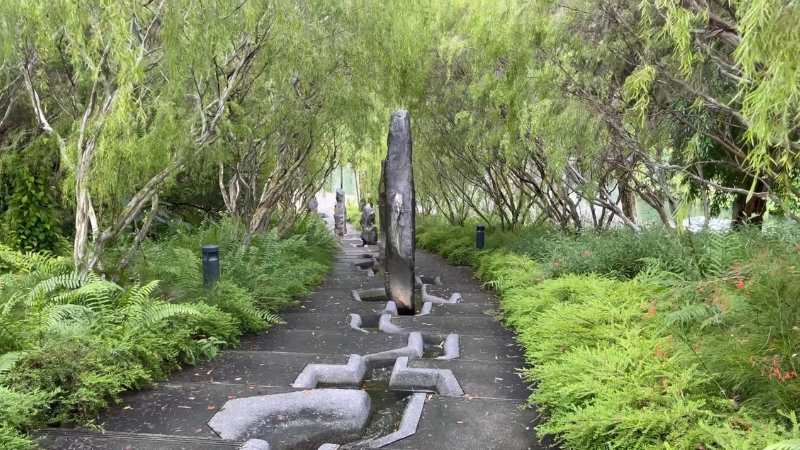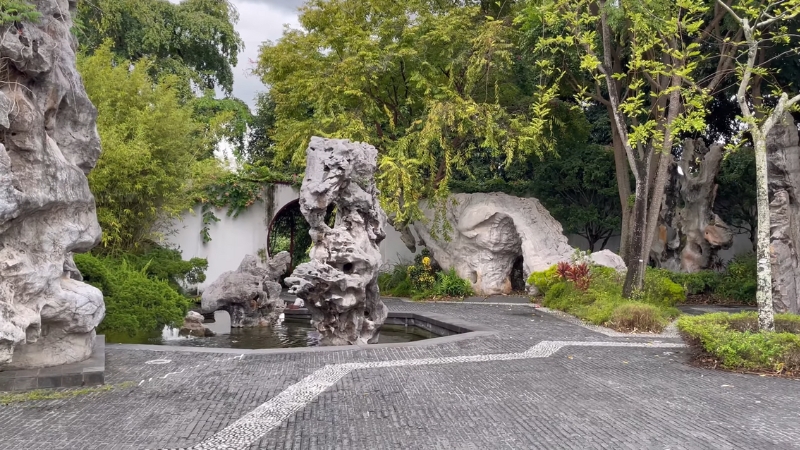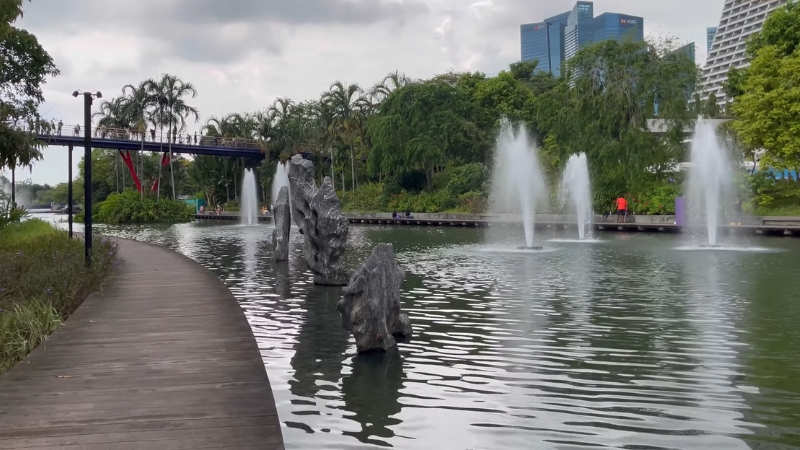The space is designed, quite literally, to calm the body and quiet the mind. Every curve of a bridge, every rock placement, even the way the sound of water bounces off stone, follows centuries-old principles meant to balance movement and stillness.
Unlike the other sections of Heritage Gardens that showcase color, rhythm, or order, the Chinese Garden works on a subtler level; it lowers your pulse.
It does it through spatial design rooted in Taoist philosophy, soft acoustic layers that drown out city noise, and symbolic plantings like lotus, bamboo, and pine that embody peace and resilience.
Walk through it, and your breathing changes without you even realizing.
The Philosophy Behind the Calm

The garden’s serenity comes from the practical application of Taoist and Confucian ideas about balance. In Chinese garden design, nature isn’t controlled; it’s guided. The goal is harmony between people and the environment.
- Curved paths slow your walk and shift your attention to the surroundings.
- Water mirrors the sky and absorbs noise.
- Rocks represent structure and endurance.
- Space matters as much as filled space.
Nothing is accidental. You move through the garden the way ink moves across paper, without force, only flow.
Walking Through: How the Layout Shapes the Mood
The garden begins with a Moon Gate, a round entrance that marks the boundary between public space and calm space. Once you step through, noise fades.
Lotus ponds sit beside rough rock clusters that resemble mountains. The contrast of hard and soft textures balances the senses.
Zigzag bridges appear often. They’re not just aesthetic; they make visitors slow down and look around. Each turn gives a different perspective: koi fish under the bridge, bamboo moving in the wind, a pavilion reflected in water.
Sound is engineered, too. Small waterfalls and streams create a steady white noise that cancels out the city. Silence here isn’t empty, it’s layered and natural.
Element
Symbolic Meaning
Design Effect
Moon Gate
Unity, transition
Signals entry into reflective space
Water
Adaptability, flow
Balances light and noise
Rocks
Strength, permanence
Adds stability and contrast
Bamboo
Resilience, integrity
Adds motion and subtle sound
Zigzag Bridge
Mindfulness
Slows walking pace
Pavilion
Rest, observation
Creates framed, shaded viewpoints
Geometry and “Borrowed Scenery”

A major concept in Chinese garden design is jiejing, or “borrowed scenery.” It means using outside views as part of the composition. Openings in walls frame distant hills, trees, or clouds. This keeps the garden connected to its surroundings instead of isolating it.
Geometry also contributes to calm. The garden avoids straight lines and right angles. Curves and diagonals guide your eyes gently, keeping attention relaxed.
Unlike Western gardens that lead to a single focal point, the Chinese layout constantly shifts your focus, from pond to rock, from window to tree, encouraging quiet exploration instead of visual control.
Plants That Influence the Mind
Plant choices here are symbolic but also sensory tools.
- Lotus grows in muddy water but blooms clean. It symbolizes purity and calm focus.
- Pine represents longevity and creates a cool, resin scent that grounds the air.
- Bamboo bends with the wind but doesn’t break, showing flexibility and stability.
- The plum blossom blooms in winter, symbolizing perseverance.
- Willow adds slow movement and shadow play, softening the scenery.
Plant
Meaning
Effect on Visitor
Lotus
Purity, growth
Gentle scent, visual calm
Bamboo
Resilience
Rustling sound, motion
Pine
Endurance
Subtle aroma, structure
Plum Blossom
Renewal
Light color contrast
Willow
Adaptation
Graceful motion, shade
Architecture That Grounds the Senses
@archimarathon There is never a bad time to visit a Chinese Garden. #architecture #architecturetravel #architectureeducation #travel #learnontiktok #tiktokpartner #architecturestudent #architecturelesson #chinesearchitecture #landscapearchitecture ♬ original sound – Archimarathon
Structures inside the Chinese Garden are small and functional. Pavilions, corridors, and bridges aren’t built to impress; they exist to support stillness.
Materials like wood, stone, and clay tiles feel natural and slightly irregular. Surfaces show age and texture, which makes them comfortable to the eye and touch.
Inside a pavilion, the design directs your view outward, toward reflections or framed trees, reminding you that the building is secondary to the landscape.
This approach removes hierarchy. You aren’t there to admire architecture; you’re part of its environment.
Time Slows Down
The Chinese Garden changes your pace. Paths are uneven, bridges turn unexpectedly, and benches appear near water. These choices make you move slowly and pay attention to your steps.
People often use the garden for tai chi or reading because the atmosphere supports a slow, continuous rhythm. The combination of shade, airflow, and low noise keeps the body relaxed. It’s the same effect mindfulness exercises aim for, but achieved through space rather than screens.
Cultural Layers: Tradition in a Modern Setting
View this post on Instagram
Within Heritage Gardens, each cultural section represents a worldview. The Chinese Garden reflects a philosophy where art, architecture, and ecology overlap. Historically, Chinese scholars built gardens as personal retreats for writing and thinking.
In Singapore, this idea is preserved with modern materials and safe accessibility. You’ll see symbolic features, stone lions, red railings, rooflines shaped like mountains, integrated without exaggeration.
The garden tells a story about migration and cultural memory while functioning as a public space for rest.
Why It Feels Different from Other Sections
The Indian Garden highlights bright colors and scent. The Malay Garden focuses on community and shade. The Colonial Garden is organized and geometric.
The Chinese Garden stands out because it values silence and equilibrium. It’s built around user experience, not display. Nothing demands attention; everything works together to steady your senses.
Garden Type
Main Feeling
Design Focus
Sound Profile
Chinese
Serenity
Balance of natural and built
Water, wind, rustle
Indian
Celebration
Color and symbolism
Bells, flowers
Malay
Abundance
Social space, shade
Birdsong, breeze
Colonial
Order
Symmetry, lawns
Footsteps, silence
Final Word

The Chinese Garden’s calm isn’t accidental. It’s the result of centuries of design meant to regulate how people feel in a space.
It shows that peace can be built through proportion, texture, and natural rhythm, not technology or noise control.
When you visit, don’t rush through. Sit near the pond, notice the air temperature shift, and let the surroundings do the rest.

